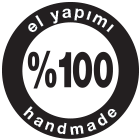Tarih boyunca ateşli silahların önemli bir unsuru olan barutu taşımak için kullanılan barutlukların yapımında boynuz, su kabağı, kın ucu gibi formlar ile deri, maden, kemik, ağaç gibi çeşitli malzemeler kullanılmıştır. Esas olarak bir hazne ve bir ağızdan oluşan barutluklar için başlangıçta kullanım özelliği ön planda olmuş, barutluklar zamanla şekil ve işlev bakımından geliştirilmiş ve her biri birer sanat eseri olarak ortaya çıkmıştır. Osmanlı döneminde kullanılan barutluk örneklerinin bir kısmı Askerî Müze Koleksiyonu’nda yer almaktadır.
Cihan Barutluk Obje üzerinde bulunan motifler, 14-16. yüzyıl Osmanlı dönemine ait süsleme özelliklerini taşıyan saz yolu üslubundan esinlenilerek oluşturulmuştur. Saz yolunun ana motifleri arasında, çok süslü ve kıvrımlı hatai tarzı stilize çiçekler, tomurcuklar, ejderha, zümrüd-ü anka kuşu gibi efsanevi, arslan, kaplan gibi yırtıcı hayvanlar, sülün, turna gibi kuşlar ve insan, melek, peri figürleri kullanılmaktadır.
Ülkemizden çeşitli yollarla götürülen veya hediye edilen barutluklar, Danimarka Davids Samling ve New York Metropolitan Müzesi gibi müzelerde sergilenmektedir.
Cihan Barutluk Obje, el imalatı smoke camdan üretilmiştir ve üzerindeki rölyef desenlerin tümü, 24 ayar altın, yaldız ve eskitme boyalar kullanılarak dekorlanmıştır.
Üretim adedi 2.000 ile sınırlıdır
Throughout history, in the making of gunpowder flasks used to carry gunpowder - an important element of firearms - forms such as horns, gourds, scabbard tips and various materials such as leather, metal, bone and wood have been used. Fundamentally made up of a receptacle and an opening, the functionality of the gunpowder flask was their most important feature at first; over time, they have been improved in terms of both shape and function, and eventually each one has emerged as a work of art. Some of the examples of gunpowder flasks used in the Ottoman period are a part of the collection at the Military Museum in Istanbul.
The motifs on the Cihan Gunpowder Horn Object draw their inspiration from the so-called saz style, an ornamentation technique dating back to the 14th-16th century Ottoman period. This technique, flourished to its fullest glory in the mid-sixteenth century, is characterized by the depiction of serrated leaf foliage, and overly stylized and ornate flowers and buds drawn in the hatai* style often paired with fantastic creatures including dragons and simurghs; beast of prey such as lions, and tigers; birds such as pheasants and cranes; and bodily forms of human, angel, and fairy figures. The technique is ascribed to the master of the style, Shah Quli, an artist who emigrated from Iran to Istanbul and became head of the royal atelier under Sultan Suleiman the Magnificent.
Some of the gunpowder flasks that are taken out of Turkey in various questionable ways or presented as gifts are now exhibited at the museums like Davids Samling Museum in Copenhagen, Denmark and the Metropolitan Museum of Art in New York, USA.
Cihan Gunpowder Horn Object is produced from handmade smoke glass and all of the relief patterns are decorated with 24-carat gold, gilt and antiquated paints.
*Hatai: is an Islamic ornamentation and abstraction technique in which the patterns are overly stylized, almost geometrical, where petals of the floral shapes usually twist inwards
Çap : 24 cm
Yükseklik : 28,5 cm
% 100 el yapımıdır.
Ürünün Menşei : Türkiye
Temizleme Önerisi : Kuru bezle siliniz
